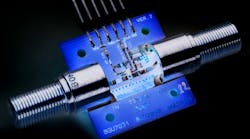Low-noise amplifiers (LNAs) are vital components in any system. While an LNA’s noise figure is generally considered the most important parameter, other factors are also significant. In the tech brief, “5 Key LNA MMIC Factors that Can Make or Break a Receiver Design,” Custom MMIC discusses five aspects other than noise figure that should be considered when selecting an LNA monolithic microwave integrated circuit (MMIC) for a system design.
The amount of input power that an LNA can withstand, or input power survivability, is the first point presented. A common approach to reduce the impact of high-power signals arriving at an LNA’s input is to place a limiter or circulator in the receiver chain prior to the LNA. However, this approach has the drawback of degrading the overall system noise figure. Some LNAs can withstand input signals with higher power levels, thereby potentially eliminating the need for a limiter.
Gain flatness over frequency and gain stability over temperature are the next topics discussed. The tech brief explains how gain flatness over frequency is important for both wideband communication systems and radar systems. Gain stability over temperature is also of importance, as some applications have operating temperatures that can vary significantly within a short time period.
The third factor is supply voltage, as properly biasing a MMIC amplifier is critical for achieving adequate performance. Additional circuitry may be required to condition an LNA’s supply voltages. This circuitry requires assembly real estate and consumes power. It also increases size, weight, and costs, as well as design and test time. The document explains the benefit of utilizing an LNA that only requires a single positive voltage supply.
The fourth factor is power consumption, which the tech brief emphasizes by noting that some applications may require numerous LNAs. The final topic is time savings, as design, assembly, test, qualification, support, and documentation all require some amount of time. Selecting insufficient LNA MMICs for a given application could create delays in one or more of these areas.
Custom MMIC, 300 Apollo Dr., Chelmsford, MA 01824; (978) 467-4290

